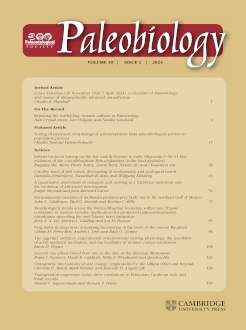Radiodonta is a group of early arthropods, distantly related to living insects and spiders, that provides insight into the origin of the segmented body plan shared by these animals. Radiodonts include some of the largest animals from the Cambrian Period; however, little has been known about their development due to a lack of juvenile specimens. We present an analysis of development of the radiodont Stanleycaris based on 265 exceptionally well-preserved specimens from the Cambrian Burgess Shale, ranging in size from 10 to 83 mm. We show that several aspects of the body shape of Stanleycaris changed as it grew. For example, the eyes were relatively larger in the smallest individuals, suggesting that juveniles were advanced visual predators. Additionally, segments were added sequentially at the rear of the body, a common developmental trait among arthropods. In light of the early evolutionary divergence of radiodonts from other arthropods, this finding provides direct evidence for a deep origin of this developmental mode. Finally, using a newly devised approach, we find evidence for two distinct fossil types of Stanleycaris, representing carcasses and molted exoskeletal remains, respectively. Based on comparison with fossils of other species, the general pattern of molting in Stanleycaris is likely shared among radiodont species and potentially other early arthropods. Altogether, our study demonstrates the first detailed view of the early development of a radiodont, providing key new evidence about the evolution of development at the origin of the arthropod body plan.
Radiodonta is a clade of stem euarthropods of central importance to our understanding of the evolution of this phylum. Radiodonts include some of the largest early Paleozoic animals; however, little is known about their ontogeny. We present an analysis of molting patterns and ontogeny in the radiodont Stanleycaris based on 265 exceptionally preserved specimens from the mid-Cambrian (Wuliuan) Burgess Shale. Ranging in size from 10 to 83 mm, they constitute the most extensive radiodont ontogenetic series known. Using a novel morphospace approach, we show that putative carcasses and exuviae can be quantitatively distinguished by the particular suites of structures preserved and their modes of preservation. We propose that Stanleycaris, and probably other radiodonts, molted via a suture near the anterior of the trunk. Similar anterior molting strategies, with a suture located at the head–trunk boundary, are shared with some Cambrian euarthropods and are potentially ancestral. Allometric analyses suggest that as Stanleycaris body size increased, the head sclerite and neck became relatively broader, while the trunk and flaps became slightly longer. The eyes developed precociously, indicating an important role of visual processing in juveniles. Finally, we find evidence for an initial anamorphic developmental phase, where segment number increased at least from 11 or 12 up to 17, followed by an epimorphic phase, in which growth continued without segment addition. This is consistent with the hypothesis that finite postembryonic segment addition (hemianamorphosis) is ancestral for arthropods and refines the timing of the origin of this important developmental mode.






